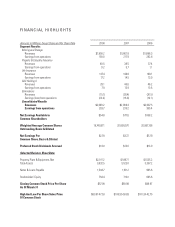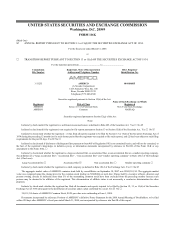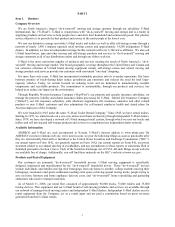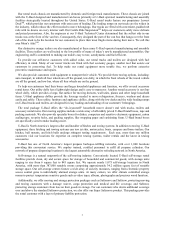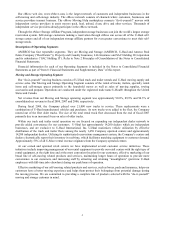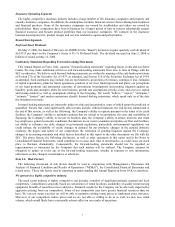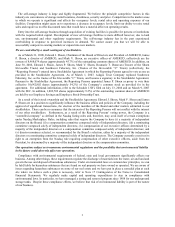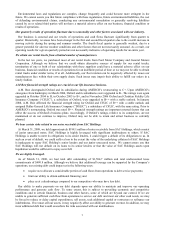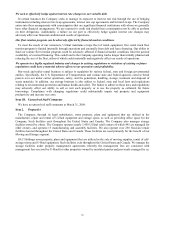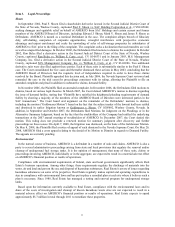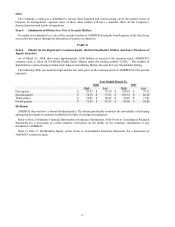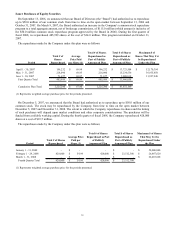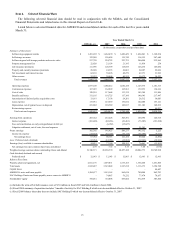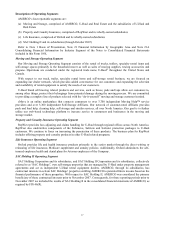U-Haul 2008 Annual Report Download - page 12
Download and view the complete annual report
Please find page 12 of the 2008 U-Haul annual report below. You can navigate through the pages in the report by either clicking on the pages listed below, or by using the keyword search tool below to find specific information within the annual report. 7
Insurance Operating Segments
The highly competitive insurance industry includes a large number of life insurance companies and property and
casualty insurance companies. In addition, the marketplace includes financial services firms offering both insurance
and financial products. Some of the insurance companies are owned by stockholders and others are owned by
policyholders. Many competitors have been in business for a longer period of time or possess substantially greater
financial resources and broader product portfolios than our insurance companies. We compete in the insurance
business based upon price, product design, and services rendered to agents and policyholders.
Recent Developments
Preferred Stock Dividends
On May 2, 2008, the Board of Directors of AMERCO (the “Board”) declared a regular quarterly cash dividend of
$0.53125 per share on the Company’ s Series A 8½ % Preferred Stock. The dividend was paid on June 2, 2008 to
holders of record on May 15, 2008.
Cautionary Statement Regarding Forward-Looking Statements
This Annual Report on Form 10-K, contains “forward-looking statements” regarding future events and our future
results. We may make additional written or oral forward-looking statements from time to time in filings with the
SEC or otherwise. We believe such forward-looking statements are within the meaning of the safe-harbor provisions
of Section 27A of the Securities Act of 1933, as amended, and Section 21E of the Securities Exchange Act of 1934,
as amended. Such statements may include, but are not limited to, projections of revenues, earnings or loss; estimates
of capital expenditures, plans for future operations, products or services; financing needs and plans; our perceptions
of our legal positions and anticipated outcomes of government investigations and pending litigation against us;
liquidity; goals and strategies; plans for new business; growth rate assumptions, pricing, costs, and access to capital
and leasing markets as well as assumptions relating to the foregoing. The words “believe,” “expect,” “anticipate,”
“estimate,” “project” and similar expressions identify forward-looking statements, which speak only as of the date
the statement was made.
Forward-looking statements are inherently subject to risks and uncertainties, some of which cannot be predicted or
quantified. Factors that could significantly affect results include, without limitation, the risk factors enumerated at
the end of this section, as well as the following: the Company’ s ability to operate pursuant to the terms of its credit
facilities; the Company’ s ability to maintain contracts that are critical to its operations; the costs and availability of
financing; the Company’ s ability to execute its business plan; the Company’ s ability to attract, motivate and retain
key employees; general economic conditions; fluctuations in our costs to maintain and update our fleet and facilities;
our ability to refinance our debt; changes in government regulations, particularly environmental regulations; our
credit ratings; the availability of credit; changes in demand for our products; changes in the general domestic
economy; the degree and nature of our competition; the resolution of pending litigation against the Company;
changes in accounting standards and other factors described in this report or the other documents we file with the
SEC. The above factors, the following disclosures, as well as other statements in this report and in the Notes to
Consolidated Financial Statements, could contribute to or cause such risks or uncertainties, or could cause our stock
price to fluctuate dramatically. Consequently, the forward-looking statements should not be regarded as
representations or warranties by the Company that such matters will be realized. The Company assumes no
obligation to update or revise any of the forward-looking statements, whether in response to new information,
unforeseen events, changed circumstances or otherwise.
Item 1A.
Risk Factors
The following discussion of risk factors should be read in conjunction with Management’ s Discussion and
Analysis of Financial Condition and Results of Operations (“MD&A”), the Consolidated Financial Statements and
related notes. These risk factors may be important in understanding this Annual Report on Form 10-K or elsewhere.
We operate in a highly competitive industry.
The truck rental industry is highly competitive and includes a number of significant national, regional and local
competitors. Competition is generally based on convenience of rental locations, availability of quality rental moving
equipment, breadth of essential services and price. Financial results for the Company can be adversely impacted by
aggressive pricing from our competitors. Some of our competitors may have greater financial resources than we
have. We can not assure you that we will be able to maintain existing rental prices or implement price increases.
Moreover, if our competitors reduce prices and we are not able or willing to do so as well, we may lose rental
volume, which would likely have a materially adverse affect on our results of operations.




